

Reticulidia halgerda
Brunckhorst & Burn, 1990
Order: NUDIBRANCHIA
Suborder: DORIDINA
Family: Phyllidiidae
DISTRIBUTION
Known from the central and western Pacific Ocean (including Fiji and the Marshall Islands), from eastern Australia to Taiwan.
PHOTO
UPPER: Collected subtidally, North West Island, Great Barrier Reef, dorsal view of 62 mm specimen, PHOTO: J. Brodie (Brunckhorst, 1993: Plate 9G).
LOWER: Koumac, New Caledonia, October 1993,
Photo: Bill Rudman
Notes compiled from Brunckhorst, 1993:
Reticulidia halgerda differs both internally and externally from species of Phyllidia and Phyllidiopsis which possess yellow coloration and tuberculate ridges. Reticulidia halgerda does not possess spiculose tubercles, but has smooth reticulate ridges on the notum whereas Phyllidia ocellata, Phyllidia tula, Phyllidia varicosa and Phyllidia coelestis have yellow capped tubercles and a different foregut.
Reticulidia halgerda lacks the broad bluish white border of Reticulidia fungia and there are numerous, narrow ridges (fewer, broad ridges in R. fungia).
Reference:
• Brunckhorst, D.J. (1993) The systematics and phylogeny of Phyllidiid Nudibranchs (Doridoidea). Records of the Australian Museum, Supplement 16: 1-107.
Rudman, W.B., 1998 (March 23) Reticulidia halgerda Brunckhorst & Burn, 1990. [In] Sea Slug Forum. Australian Museum, Sydney. Available from http://www.seaslugforum.net/find/retihalg
Related messages
Re: Reticulidia halgerda from the Philippines
November 18, 2009
From: Paul Bourdin
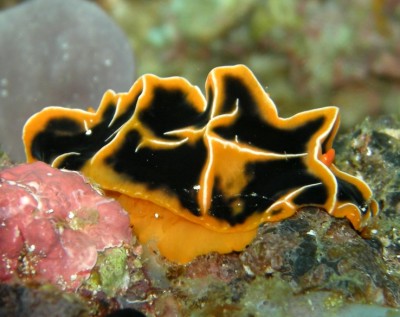
Concerning message #19568:
Another picture from the Philippines. This one from just across the channel, at Anilao.
Locality: Beatrice Reef, Anilao, 25m, Batangas, Philippines, South China Sea, 8 November 2009, Coral reef. Photographer: Paul Bourdin.
Paul Bourdin
paulsbourdin@yahoo.co.uk
Bourdin, P.S., 2009 (Nov 18) Re: Reticulidia halgerda from the Philippines. [Message in] Sea Slug Forum. Australian Museum, Sydney. Available from http://www.seaslugforum.net/find/22770Thanks Paul,
Best wishes,
Bill Rudman
Reticulidia halgerda from the Philippines
April 16, 2007
From: Mike Krampf
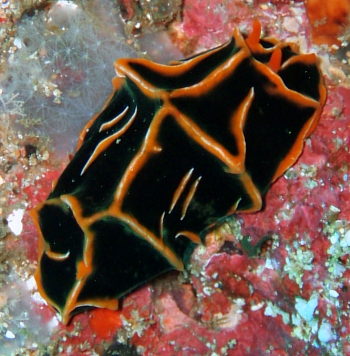
Here are a couple of pictures of Reticulidia halgerda. I didn't see an postings of this species from the Philippines so I thought you might like some pictures to help with the geographic distribution of the species.
Locality: Sabang Beach, 50 ft, Puerto Galera, Philippines, South China Sea, 19 Feb 2007, Reef. Length: 4-5 cm. Photographer: Mike Krampf.
Cheers,
Mike
mtkrampf@yahoo.com
Krampf, M., 2007 (Apr 16) Reticulidia halgerda from the Philippines. [Message in] Sea Slug Forum. Australian Museum, Sydney. Available from http://www.seaslugforum.net/find/19568
Thanks Mike,
The other interesting observation from your photo alongside is the bright orange sponge which seems to be partially eaten. David Brunckhorst (1993) records this species feeding on a bright orange encrusting verongid sponge of the genus Aplysina. Although its probably impossible to identify from the photo alone, this could well be the same sponge.
You might say 'what about the gray sponge in the upper photo?' Its hard to be sure from photos just what is going on, but in the upper photo the animal is fully extended and has its rhinophores out - it looks as though it going somewhere. In the bottom photo the slug is clearly stopped and seems to have its head moving around on the orange sponge. I may be wrong, but to me it indicates this animal has stopped and is at least investigating the orange sponge, if not actually eating it. Some one say this is not scientific proof, which I would agree with, but if I have a number of different records of this species photographed on the same sponge, then I think we would be silly to ignore it. As long as you make it quite clear what your evidence is, then no one is being misled.
Best wishes,
Bill Rudman
Reticulidia halgerda from Fiji
May 24, 2006
From: Leanne & David Atkinson
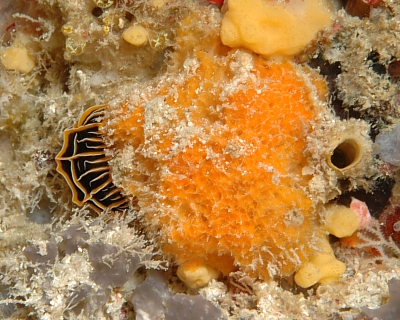

Dear Bill,
On a recent trip to Fiji we came across this spectacular nudibranch. We have been to the same area 5 times before, always in April when the water is 29 degrees celcius and have never seen this nudibranch before. We've identified it from the Sea Slug Forum Fact Sheets as Reticulidia halgerda. We found it in a little cave/hollow on an orange sponge (in the first shot) and wondered if this was its food. There doesn't seem to be any information on its food in the fact sheet. We moved it to get a better picture to identify it. The hollow was so small that we couldn't fit our subal housing in to get a closeup shot.
Locality: Gotham City, near Mana Island, Mamanuca Islands, 20metres, South West Fiji, Pacific, 25 April 2006, Tropical Coral Reef Bommie. Length: approximately 20mm. Photographer: Leanne & David Atkinson.
The local dive guides say that nudibranchs are more common in their area later in the year when the water is cooler. The water temperature drops later in the year to 26 degrees celcius. We wondered if people could include water temperature in their details if they know it since this may be important information re the environmental conditions required for some species. Even tropical areas have fluctuations in their water temperature that may affect nudibranch behaviour.
Thanks,
Leanne & David Atkinson
atk@hunterlink.net.au
Atkinson, L. & D., 2006 (May 24) Reticulidia halgerda from Fiji. [Message in] Sea Slug Forum. Australian Museum, Sydney. Available from http://www.seaslugforum.net/find/16668
Dear Leanne & David,
This association with an orange sponge is very interesting - especially since your clear photo should enable us to identify the sponge. The only information we have on its feeding is a photo I was sent from Vanuatu by Ian Knight in 1984, which showed an encrusting orange sponge. When David Brunckhorst was working on these animals he had the sponge in the photo tentatively identified as a species of Verongia [Aplysinidae, Verongida], so your photo could well be another record of it on the same orange sponge.
Concerning water temps, I am happy for them to be included in data. 'Seasons' in the sea are quite complex. As you say, even in the tropics there is a fluctuation in temperature during the year, and there are also definite cyclical presences and absences of species during the year. Sometimes water temperature seems to be involved, but other times it seems changes in salinity brought about the huge influx of freshwater during the rainy season may be the trigger to particular biological events. We still have much to learn, and every little bit helps.
Best wishes,
Bill Rudman
Reticulidia halgerda from Fiji
July 10, 2003
From: Mary Jane Adams

Hi Bill,
Here is a record of Reticulidia halgerda from Fiji. I photographed it in the Vatu-I-Ra Passage between Vitu Levu and Vanua Levu. It was sitting on dead coral on a reef slope.
Length: about 20mm
Depth: about 20 metres
Date: May 11, 2003
Best regards,
Mary Jane
divepng@yahoo.com
Adams, M.J., 2003 (Jul 10) Reticulidia halgerda from Fiji. [Message in] Sea Slug Forum. Australian Museum, Sydney. Available from http://www.seaslugforum.net/find/10119Thanks Mary Jane,
Bill Rudman
Reticulidia halgerda from the Solomons
September 14, 2001
From: Bruce Potter
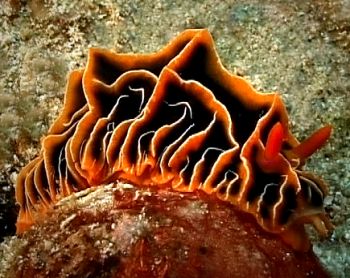
Dear Bill,
I found this Reticulidia halgerda on last weekend's trip to the Russell Islands, in the Solomon Islands.
It was on a sheer wall at a dive site named Kau Kau. It was at about 15 meters.
Regards
Bruce Potter.
bruce.potter@adventist.org.sb
Potter, B., 2001 (Sep 14) Reticulidia halgerda from the Solomons. [Message in] Sea Slug Forum. Australian Museum, Sydney. Available from http://www.seaslugforum.net/find/5256Thanks Bruce,
Bill Rudman
Reticulidia halgerda & R. fungia togetherter
February 4, 2001
From: Mary Jane Adams

Hi Bill,
I took this picture of Reticulidia halgerda and Reticulidia fungia at 16 meters on a reef in Bootless Bay, Papua New Guinea on May 10, 2000. This is the position I found them in at the beginning of the dive. During the next hour the R. halgerda crawled over the R. fungia and moved away while the R. fungia stayed in the same spot. My interpretation is that the R. halgerda was following a trail left by the R. fungia, but could not tell that is was a different species until it actually made contact. What do you make of this?
Best regards,
Mary Jane
divepng@yahoo.com
Adams, M.J., 2001 (Feb 4) Reticulidia halgerda & R. fungia togetherter. [Message in] Sea Slug Forum. Australian Museum, Sydney. Available from http://www.seaslugforum.net/find/3692Dear Mary Jane,
We know very little about behaviour in nudibranchs. I don't know of any study that demonstrates the presence of pheromones or equivalent chemical attractants being produced to attract mates. It is possible that many can sense a chemical in the mucus trail of other animals, but this has not been demonstrated except in some case of predators stalking prey, such as Navanax inermis. One phenomenon we often notice when collecting nudibranchs of the same species and keeping them in small containers is that they quickly end up mating. I personally don't think this is because they are sex crazed but rather because they only recognise their own kind when in actual contact. In the natural environment their chances of meeting would be quite slim so it would be pretty important to mate every time contact was made.
In this case I suspect that R. halgerda treated R. fungia as part of the substrate, crawling over it simply because it was in the way. But that is only my guess, which is no better than your suggestion at this stage.
Best wishes,
Bill Rudman.
Reticulidia halgerda from the Solomon Islands
February 4, 2001
From: Mary Jane Adams
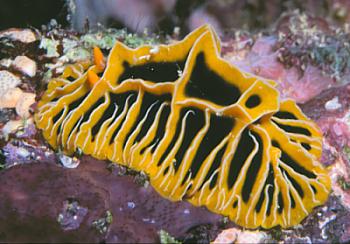
Hi Bill,
I saw this Reticulidia halgerda sitting on the same spot over several days. It was on a point of Karumolun Island, Russell Group, Solomon Islands
Length: 18 mm
Depth: 7 meters
November, 1999
Best regards,
Mary Jane
divepng@yahoo.com
Adams, M.J., 2001 (Feb 4) Reticulidia halgerda from the Solomon Islands. [Message in] Sea Slug Forum. Australian Museum, Sydney. Available from http://www.seaslugforum.net/find/3693Dear Mary Jane,
I wonder if it had found a nice source of food? It might be worth having a look to see if an animal is feeding, or egg laying, or perhaps brooding an egg mass, if you find it in the same spot for a lengthy period of time.
I suspect with phyllidiids, such as Reticulidia you might need to lift them up to see if there is obvious damage to a sponge beneath them. Phyllidiids, have lost their rasping radular teeth so apparently feed by sucking in the sponge tissue after it is reduced to a 'soup' by digestive enzymes 'spat out' through the proboscis. If you lifted one up and it was feeding you would probably find an extended tube-like proboscis. A photo of the sponge it was feeding on, if not a sample of the sponge, would be a valuable bit of information to have about their natural history.
Best wishes,
Bill Rudman.
Reticulidia halgerda & R. fungia
November 28, 1999
From: Bill Rudman
Here are pages on the two Halgerda-like phyllidiids, Reticulidia halgerda and Reticulidia fungia .
Bill Rudman.
Re: Decorated Phyllidia
March 25, 1998
From: Dr. A.D.Wright
Hi Bill,
Thanks very much for the info. I find nudibranchs fascinating animals both to observe and chemically. We rarely collect them as to do good chemical analyses we need about 10 gm dry weight of animals and normally we don't find this many in any one place, so we leave them alone. The ones (actually 2) I recently collected are from Fiji and were found feeding, so we collected them and their food (a sponge) and will do a very careful analysis of both by GC-MS, hence I don't need much animal. The other is clearly a Phyllidia sp., but I don't know which one yet as it is not in any of the books I have, perhaps I should send you a photo.
If you or your colleagues ever have any interesting animals that you think might be worthwhile us investigating just let me know.
Details on Reticulidia halgerda: Single animal, 5 cm long, on open surface under a large overhang. Bommie directly off Dravuni Island research station, Fiji., 10 m, 21/1/98, (CT198G).
Cheers for now and many thanks for your help,
Tony
Dr. A.D.Wright
a.wright@tu-bs.de
Wright, A.D., 1998 (Mar 25) Re: Decorated Phyllidia. [Message in] Sea Slug Forum. Australian Museum, Sydney. Available from http://www.seaslugforum.net/find/122Re: Decorated Phyllidia
March 23, 1998
From: Dr. A.D.Wright
Hi Bill, A very good response!
I got the trivial name from Neville Coleman's "Nudibranchs of the South Pacific" Vol. 1, pg 49. I was also surprised no species was assigned to this rather distinctive looking beast.
Cheers,
Dr. Anthony D. Wright,
Technical University Braunschweig,
Institute for Pharmaceutical Biology
Mendelssohnstrasse 1
D-38106 Braunschweig
Germany
http://www.tu-bs.de/institute/pharm.biol/GAWK.html
a.wright@tu-bs.de
Wright, A.D., 1998 (Mar 23) Re: Decorated Phyllidia. [Message in] Sea Slug Forum. Australian Museum, Sydney. Available from http://www.seaslugforum.net/find/121That makes it easy. It is Reticulidia halgerda, which is one of a pair of species which have a pattern of reticulate ridges over their mantle. Superficially they look like species of the dorid genus Halgerda, hence the species name.. Neville Coleman did not use a species name because it was not described as a new species until a year after Neville's book was published. Have you a general interest or are you looking at some interesting chemical compounds in phyllidiids?...Bill Rudman
Rudman, W.B., 1998 (Mar 23). Comment on Re: Decorated Phyllidia by Dr. A.D.Wright. [Message in] Sea Slug Forum. Australian Museum, Sydney. Available from http://www.seaslugforum.net/find/121Decorated Phyllidia
March 20, 1998
From: Dr. A.D.Wright
Greetings Bill,
Could you tell me the species of the Phyllidia nudibranch more commonly known as the Decorated Phyllidia and who the original author was.
Many thanks,
Dr. A.D.Wright
a.wright@tu-bs.de
Wright, A.D., 1998 (Mar 20) Decorated Phyllidia. [Message in] Sea Slug Forum. Australian Museum, Sydney. Available from http://www.seaslugforum.net/find/120Common names are a major problem. Some such as the "Sargassum Sea Slug" (Scyllaea pelagica) are easy to guess at but "Decorated Phyllidia" is not so easy. The obvious choice "Phyllidia decorata" doesn't exist. If you could let me know where you got the common name from I might be able to help. If anyone else has seen the name used and can offer a suggestion please do. Common names are usually not "common" at all. Often book publishers insist that authors make them, up fearing readers will be intimidated by scientific names. All this does is lead to confusion and misidentifications.. Bill Rudman
Rudman, W.B., 1998 (Mar 20). Comment on Decorated Phyllidia by Dr. A.D.Wright. [Message in] Sea Slug Forum. Australian Museum, Sydney. Available from http://www.seaslugforum.net/find/120